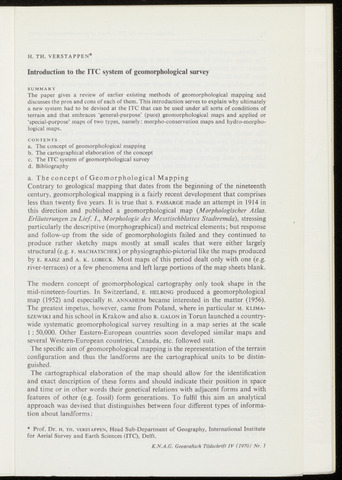Introduction to the ITC system of geomorphological survey
a. The concept of Geomorphological Mapping
Contrary to geological mapping that dates from the beginning of the nineteenth
Century, geomorphological mapping is a fairly recent development that comprises
less than twenty five years. It is true that s. passarge made an attempt in 1914 in
this direction and published a geomorphological map Morphologischer Atlas.
Erläuterungen zu Lief. Morphologie des Messtischblattes Stadtremdastressing
particularly the descriptive (morphographical) and metrical elements; but response
and follow-up from the side of geomorphologists failed and they continued to
produce rather sketchy maps mostly at small scales that were either largely
structural (e.g. f. machatschek) or physiographic-pictorial like the maps produced
by E. raisz and A. k. lobeck. Most maps of this period dealt only with one (e.g.
river-terraces) or a few phenomena and left large portions of the map sheets blank.
The modern concept of geomorphological cartography only took shape in the
mid-nineteen-fourties. In Switzerland, e. helbing produced a geomorphological
map (1952) and especially h. annaheim became interested in the matter (1956).
The greatest impetus, however, came from Poland, where in particular m. klima-
szewski and his school in Krakow and also r. galon in Torun launched a country-
wide systematic geomorphological survey resulting in a map series at the scale
150,000. Other Eastern-European countries soon developed similar maps and
several Western-European countries, Canada, etc. followed suit.
The specific aim of geomorphological mapping is the representation of the terrain
configuration and thus the landforms are the cartographical units to be distin-
guished.
The cartographical elaboration of the map should allow for the identification
and exact description of these forms and should indicate their position in space
and time or in other words their genetical relations with adjacent forms and with
features of other (e.g. fossil) form generations. To fulfil this aim an analytical
approach was devised that distinguishes between four different types of informa-
tion about landforms:
H. TH. VERSTAPPEN*
SUMMARY
The paper gives a review of earlier existing methods of geomorphological mapping and
discusses the pros and cons of each of them. This introduction serves to explain why ultimately
a new System had to be devised at the ITC that can be used under all sorts of conditions of
terrain and that embraces 'general-purpose' (pure) geomorphological maps and applied or
'special-purpose' maps of two types, namely: morpho-conservation maps and hydro-morpho-
logical maps.
CONTENTS
a. The concept of geomorphological mapping
b. The cartographical elaboration of the concept
c. The ITC system of geomorphological survey
d. Bibliography
Prof. Dr. h. th. verstappen, Head Sub-Department of Geography, International Institute
for Aerial Survey and Earth Sciences (ITC), Delft.
K.N.A.G. Geografisch Tijdschrift IV (1970) Nr. I

